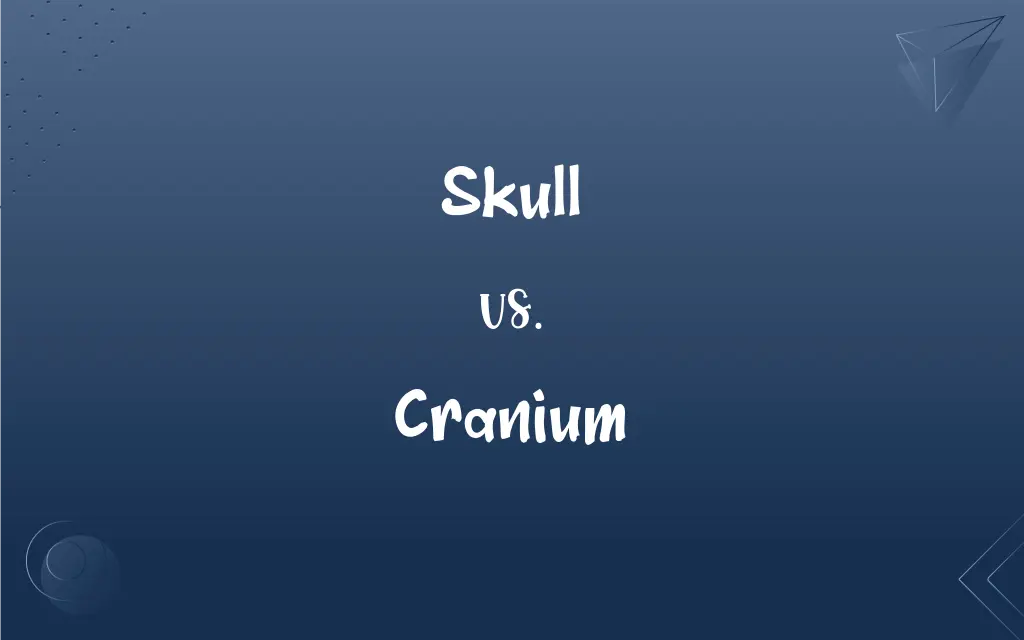Skull vs. Cranium: What's the Difference?
Edited by Janet White || By Harlon Moss || Updated on October 20, 2023
The skull is the bony structure of the head, while the cranium is the part that encloses the brain.

Key Differences
The skull is a complex structure, comprising 22 bones in total. It serves as the framework for the face and contains cavities for the brain, eyes, ears, nose, and mouth. On the other hand, the cranium specifically refers to the part of the skull that envelops and protects the brain.
When we discuss the skull, we're often referring to both facial bones and the bones of the cranium. The facial bones are those that give shape to the face, such as the cheekbones and jaw. The cranium, though, doesn't include these facial bones; it is solely focused on the brain's protective case.
The skull's primary function is to offer a hard casing for the brain and facial features, safeguarding them from injury. In contrast, the cranium's main role is the vital job of enclosing the brain, providing a defense against external forces.
The word "skull" can also be used in a broader sense, representing the whole bony frame of the head, including the jawbone. The cranium, however, always denotes the upper part of the skull, excluding the mandible or jawbone.
In forensic studies, anthropology, and archaeology, the analysis of the skull provides clues about age, sex, and sometimes race or ethnicity. The cranium, in these disciplines, is essential for studying brain development, shape, and size over evolutionary periods or within specific populations.
ADVERTISEMENT
Comparison Chart
Definition
The bony structure of the head, including facial bones.
The part of the skull that surrounds and protects the brain.
Components
Comprises 22 bones, both facial and cranium.
Consists of 8 bones.
Inclusion of Jaw
Includes the mandible (jawbone).
Does not include the mandible.
Broader Usage
Can refer to the entire head's bony structure.
Specifically refers to the upper part of the skull.
Function
Provides support for facial features and protection for brain and sensory organs.
Solely protects the brain from external injury.
ADVERTISEMENT
Skull and Cranium Definitions
Skull
The bony framework of the head.
She fractured her skull in the accident.
Cranium
The upper part of the skull that encloses the brain.
The cranium is essential for protecting our brain.
Skull
A protective casing for the brain and sensory organs.
He wore a helmet to protect his skull during the bike race.
Cranium
The set of eight bones that form the brain's case.
In anatomy class, they learned about the different bones that make up the cranium.
Skull
The entirety of bones comprising the head's structure.
The museum displayed a human skull next to a primate's.
Cranium
The bony structure surrounding the brain, excluding the jaw.
She was fascinated by the shape of the cranium in different species.
Skull
A representation or model of the head's bony structure.
The art class used a plastic skull for their drawing exercise.
Cranium
A protective case solely for the brain.
Helmets are designed to provide extra protection for the cranium.
Skull
The head as a symbol of death or danger.
Pirates often use a skull and crossbones on their flags.
Cranium
The part of the skull studied for brain development analysis.
Anthropologists often examine the cranium to understand human evolution.
Skull
The bony or cartilaginous framework that encloses and protects the brain and sense organs of all vertebrates and of one group of nonvertebrates (the hagfishes); cranium.
Cranium
The skull.
Skull
(Informal)The head, regarded as the seat of thought or intelligence
Use your skull and solve the problem.
FAQs
Does the cranium include the jawbone?
No, the cranium does not include the jawbone; that's part of the skull but outside the cranium.
What is the skull?
The skull is the bony structure of the head, encompassing both the cranium and facial bones.
How many bones are in the cranium?
The cranium consists of 8 bones.
Are the terms skull and cranium interchangeable?
Not exactly. While all cranial bones are part of the skull, not all skull bones are part of the cranium.
Can the word "skull" refer to a symbol?
Yes, the skull can symbolize death or danger, as in the skull and crossbones.
Is the cranium involved in forensic investigations?
Yes, the cranium can provide insights into cause of death, age, and identity in forensics.
How many bones make up the skull?
The skull is made up of 22 bones in total.
What is the cranium?
The cranium is the upper part of the skull that specifically encloses and protects the brain.
Is the skull only associated with humans?
No, many vertebrates, including animals, have skulls.
Why is the cranium important?
The cranium protects the brain from external injury.
What's the role of the skull in anthropology?
In anthropology, the skull provides insights about age, sex, race, and evolutionary patterns.
Do the skull and cranium have different functions?
Yes, while the skull supports and protects both the brain and facial features, the cranium specifically safeguards the brain.
Which is more robust, the skull or the cranium?
Both are sturdy, but the cranium has a particular thickness to protect the brain.
How does the cranium change as we grow?
The cranium expands as the brain grows, especially during early childhood, and then its growth slows.
Can skull shape differ among individuals?
Yes, skull shapes can vary based on genetics, ethnicity, and other factors.
What is the relationship between the skull and the brain?
The skull, especially the cranium, serves as a protective case for the brain.
Do all animals have a cranium?
Not all, but many vertebrates have a cranium to protect their brains.
Can injuries to the skull affect the cranium?
Yes, injuries to the skull can potentially damage the cranium and thereby the brain.
Where can I find the cranium in the skull?
The cranium is the upper part of the skull, excluding the jaw.
Why is the skull often studied in anatomy classes?
The skull, including the cranium, provides insights into human evolution, development, and anatomy.
About Author
Written by
Harlon MossHarlon is a seasoned quality moderator and accomplished content writer for Difference Wiki. An alumnus of the prestigious University of California, he earned his degree in Computer Science. Leveraging his academic background, Harlon brings a meticulous and informed perspective to his work, ensuring content accuracy and excellence.
Edited by
Janet WhiteJanet White has been an esteemed writer and blogger for Difference Wiki. Holding a Master's degree in Science and Medical Journalism from the prestigious Boston University, she has consistently demonstrated her expertise and passion for her field. When she's not immersed in her work, Janet relishes her time exercising, delving into a good book, and cherishing moments with friends and family.































































